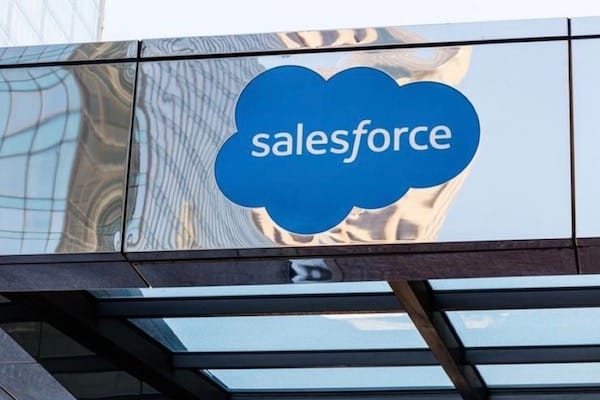Since its inception, Salesforce, the world’s largest and most profitable cloud computing provider, was in search of a logo that stood out on every platform, from promotional t-shirts to small phone screens. The company finally developed a strong visual identity in 2014.
The Salesforce logo was inspired primarily by other major online-based companies. With its aqua blue, fizzing cloud shape and white sans serif wordmark inside, it definitely looks more like the Skype logo. The color of the logo is also the same as that of Twitter and Vimeo.
But while the Salesforce logo is not the most distinctive, the color scheme helps to make it appear welcoming, friendly, trustworthy, and reliable. It has undergone some significant changes since its inception. This article will cover those changes, the meaning of the Salesforce logo, its history, and all you should know about the design.
Salesforce Logo: Meaning
The old Salesforce logo featured the company’s name inside a cloud. Because of the 3D effect, the cloud appeared almost real. The cloud was light blue and white on the inside. The middle was white, but as you got closer to the edges, the color of the background became more intense.
What Exactly is Salesforce?
It is a software company based in the United States. It offers a cloud-based database management service (under the Database.com brand) and a platform as a service (PaaS) system for custom application development. Salesforce first appeared in the year 1999.
The Evolution of the Salesforce Logo
Salesforce’s visual identity is very consistent. Throughout its history, the company has only had two emblems: the original one designed in 1999 and the current updated version designed in 2014. They have the same design in that they both have a cloud with the inscription “Salesforce” within it.
1999-2014
The original Salesforce logo featured the company name within a cloud that appeared almost real due to the 3D effect. The designers used a radial oval gradient to create a 3D effect, with colors flowing smoothly from white (center) to aqua blue (around the margins).
Furthermore, the uneven color scheme made the thin outline around the cloud appear three-dimensional—shadows and highlights created an impression of spatial presence.
The name of the cloud computing company was written in lowercase characters inside the cloud. The word “Salesforce” was visually divided in half. The “Sales” portion on the left was gray, while the “Force” portion on the right was black. Furthermore, the designers used italic font for the “f”; this letter appears to separate the two halves of the wordmark.
2014-Present
Salesforce changed its logo slightly fifteen years after it was founded. While all elements remained in the same places, they began to look different.
Now, the developers adhered to the simplicity principles, which emphasize two-dimensional graphics. As a result, the gradient that created the 3D effect in the cloud was removed. At the same time, the cloud’s “convex” outline vanished.
Furthermore, the font was simplified. The previous serif font was replaced by a more defined sans serif font. The new letters had a distinct shape, but the lines remained smooth. The color scheme has also been changed: the wordmark “Salesforce” is now completely white. This is yet another example of the brand’s elegant simplicity.
No Software Emblem
CEO Marc Benioff created the “No Software” emblem as part of the company’s marketing campaign. Although it was never designated as the official logo, it did appear in advertisements.
Elements of Salesforce Logo Design
Symbol
Salesforce’s logo is appropriately shaped for a major player in the cloud computing world. It resembles a lush cloud composed of six circles of varying diameters.
Furthermore, the chosen style appears to be more akin to children’s drawing than to modern computer graphics. The symbol was originally three-dimensional, but the company later abandoned the three-dimensional style in favor of a minimalist two-dimensional design.
Color
While the cloud shifted dramatically from bright blue to white, the wordmark placed inside the cloud had a gray-and-black color scheme.
The 2014 redesigned Salesforce logo is easy on the eyes because the designers chose a bright blue and white color scheme. As a result, the logo has a well-balanced and professional appearance.
Font
The dominant font in the Salesforce logo is similar to the Aller Regular font, while the “f” is an italicized variant of the same typeface. Dalton Maag designed Aller Regular, a type of sans serif font.
Salesforce’s Background
Salesforce is one of the largest software companies in the world. The company, headquartered in San Francisco, reportedly earned $13.28 billion in revenue in 2019, making it one of the world’s largest software income earners. That’s no small feat for a company that’s only been around for a little more than two decades.
So, how did the company become one of the world’s leading cloud-based software providers? It’s an enthralling story for anyone who wants to work for a software company or start their own.
History from the Beginning
Salesforce was founded in 1990 by Marc Benioff. Benioff was a sales manager at Oracle, one of the world’s largest software companies, at the time.
Benioff founded Salesforce on a daring premise: that the general public should have access to software 24 hours a day, seven days a week, via a global computing infrastructure. Companies would no longer need to hire expensive software companies like Oracle or SAP to set up individual computer systems on their premises at exorbitant costs.
Benioff foresaw a future in which any company in the world could purchase software programs outside of its own premises, at a lower cost and with equal or higher efficiency, and have everything safely stored on an outside cloud.
That singular idea was scorned by the world’s leading software vendors, who saw Salesforce as a threat to their business. However, Benioff and Salesforce went on to become computing revolutionaries. They humbled their critics by developing a single innovation—a customer relationship management platform—based on a single concept—creating products that businesses could use in the cloud.
Benioff’s concept had businesses looking for software products and services that would make it easier and more efficient for employees to use software whenever and however they saw fit. Salesforce’s customer relationship management (CRM) software, in particular, would be extremely affordable, simple to install, and user-friendly. It would easily integrate with existing software systems and “run faster than lightning,” according to Salesforce.
The Ascension of Salesforce
After launching Salesforce in typical Silicon Valley fashion, Benioff developed the blueprint for his new company in his tiny apartment in Telegraph Hill near San Francisco’s city center.
He created the blueprint with the help of three business associates, Dave Moellenhoff, Frank Dominquez, Parker Harris, Larry Ellison, Halsey Minor, and other investors. Ellison was the founder and CEO of Oracle at the time, while Halsey Minor was the founder of CNET.
Salesforce took a long time to get off the ground, but the company turned a corner after its first Dreamforce annual convention in 2003, which drew thousands of potential customers to San Francisco’s Westin Hotel.
With the Salesforce brand name being well-known among many potential customers and investors, the company held an IPO in 2004, raising $110 million. On the first day, the company’s stock price was $17.25 per share; today, the stock price is $203 per share.
Salesforce continued to expand, and by 2009, it had more than $1 billion in annual revenue and a record 55,000 customers within ten years. Within two years, the company nearly doubled its customer base and gained prominence after Forbes named it “the most innovative company in the world.”
In 2013 and 2014, there was more growth and more acquisitions. Salesforce paid $2.5 billion for ExactTarget’s email service provider in 2013. ExactTarget later evolved into The Marketing Cloud, its primary product and service offering, supplying critical software marketing automation systems and tools to its expanding customer base.
Read Also: Buffalo Bills Logo: Why is the Logo a Bison?
Salesforce quickly expanded into six new industries around the world, including the lucrative and high-profile life sciences and healthcare sectors, bolstering its global brand. The company’s existing and new customers would soon be successfully integrated into its expanding Health Cloud software environment.
Other cloud-based ventures followed, and by 2017, Salesforce had annual revenues of $8.3 billion. In 2018, business was so good that Benioff and his management team relocated Salesforce’s operations to the Salesforce Tower, which dominates the San Francisco skyline. Revenues increased to $10.4 billion that year.
Salesforce would follow that up with its largest-ever acquisition, a $6.5 billion stake in MuleSoft, a leading cloud computer-integration provider with major clients including Coca-Cola, Unilever, and Barclays.
Salesforce employees were also pleased. Indeed, Fortune named Salesforce one of the best companies to work for in America in 2018 and 2019.
Salesforce co-CEO Keith Block left the company in February 2020. Marc Benioff retained his positions as CEO and Chairman. Salesforce announced in December of that year that it would acquire Slack for $27.7 billion. It completed the acquisition in July 2021.
Salesforce chief financial officer Mark Hawkins announced his resignation in February 2021 after more than six years with the company; however, he will remain as honorary CFO until October. Amy Weaver was named as his replacement by the company.
Lows at Salesforce
Like any other company, Salesforce has experienced highs and lows throughout its history.
In 2007, an email phishing attack hit Salesforce, allowing cyber criminals to access the contact information of Salesforce customers. According to reports, one of the company’s salespeople unintentionally provided log-in information to a cyber thief.
Salesforce found itself in hot water in 2019 on both the cultural and tax fronts. Despite doing so legally, Salesforce was one of several Fortune 500 companies that effectively paid 0% or less in US taxes that year.
Nonetheless, 50 women filed a civil lawsuit against Salesforce in 2019, accusing Backpage.com, a Salesforce client, of facilitating rape, abuse, and sex trafficking with the company’s full knowledge. The company was cleared after a judge dismissed the lawsuit in late 2019.
Salesforce Today and the Future of Salesforce
Salesforce was one of the world’s most popular computer software companies by 2020, with a market capitalization of $156 billion and an estimated stock price of $203 per share.
According to a FactSet.com research report from 2010, the CRM is considered a “investment” or “overweight” by an overwhelming majority of technology industry analysts.
That’s quite an accomplishment for a company that was once mocked as a “picnic ant.”
However, Salesforce is now a market leader. It helped to establish and has ruled the world of cloud computing for the last two decades.
Who Owns Salesforce?
Benioff is best known for his roles as co-founder, chairman, and CEO of the software company Salesforce. Since 2018, he has also served as the owner of the publication Time.
Is Salesforce used in the United Kingdom?
Salesforce operates on a global scale, with the United Kingdom being one of its most important markets. Salesforce has recently surpassed Microsoft as the most popular CRM provider in the United Kingdom.
Is Salesforce a Website?
Salesforce is a software development company that also operates an online platform, resulting in a website. Salesforce operates through the salesforce.com website, and the company’s physical headquarters are in the Salesforce Tower, a building in San Francisco, California.
History of Salesforce: Conclusion
Salesforce is a cloud-based software company headquartered in San Francisco, California, in the Salesforce Tower. The firm provides customer relationship management software as well as enterprise applications focused on customer service, application development, analytics, and market automation.
Salesforce was founded in February 1999 as a Software as a Service (SaaS) provider by ex-Oracle sales executive Marc Benioff, Frank Dominguez, Dave Moellenhoff, and Parker Harris. It was publicly launched from September to November 1999.
Salesforce has regional headquarters in Morges, Switzerland (which serves Europe, Africa, the Middle East, and Singapore), India (which serves Asia Pacific except Japan), and Tokyo (which serves Japan). Salesforce has offices in Chicago, Toronto, New York, San Mateo, London, Sydney, Dublin, Hyderabad, Indianapolis, Vancouver, and Hillsboro, Oregon.
Read Also: Bentley Logo: What Does It Mean?
By the end of July 2011, the company’s services had been translated into 16 different languages, with more than 2.1 million subscribers and 104,000 customers. Salesforce relocated its Midwest regional headquarters to Indianapolis in 2017.
Salesforce went public on the NYSE in June 2014, raising $110 million under the CRM stock symbol. Halsey Minor, Larry Ellison, Magdalena Yesil, Mark Iscaro, Stewart Henderson, and Igor Sill, one of Geneva Venture Partners’ founders, were among the early investors.
Salesforce is continuing to set the standard for SaaS innovation today and in the future. Between 2006 and 2019, Salesforce acquired 52 companies, many of which became key products in the company’s suite.
Even today, the company makes significant acquisitions. With the acquisition of Demandware, a company that provides B2C enterprise cloud software solutions for retail stores, it has expanded into horizontal markets such as e-commerce.
Related Articles
- CRM Analytics: A Detailed Guide
- BEST CRM FOR SMALL BUSINESS: Top CRM for Sales, Consulting & Manufacturing Business
- LEAD CONVERSION: Examples and Rates
- Top 10 Sales Software In 2023: Free and Paid Options
- WHAT IS SALESFORCE: Meaning, Software, Training & Administration






